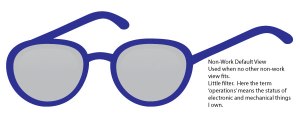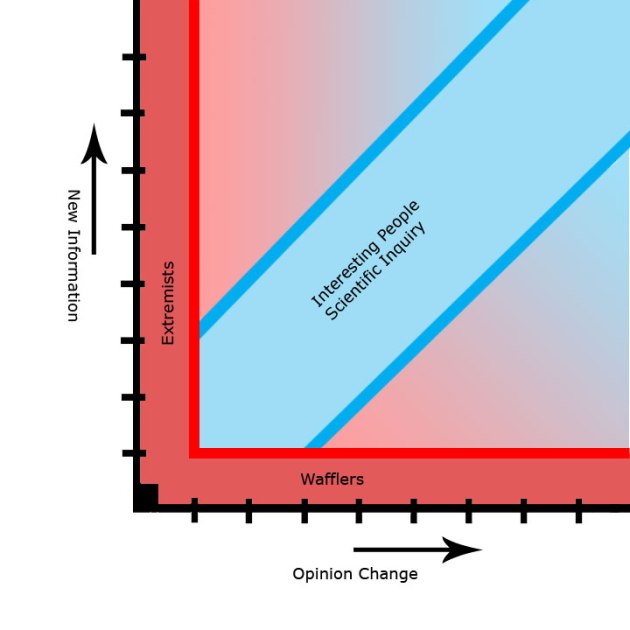Testing the new Site
June 23, 2013 Leave a comment
This is just a test of the new site.

This blog is meant to help put my thoughts and concepts in order and to help test them for accuracy.
June 11, 2013 1 Comment
As part of my learning to be a better blogger/communicator, I have been extremely bogged down in learning the world of Graphic Design.
The book I am currently reading is on Color Theory. At the end of the third chapter, the author details several different color schemes but did not show any graphics. I decided to create those graphics to see how they look. It ended up taking significantly longer than I had initially intended.
This is the result of that work. I think I really dig the Monochromatic scheme. I truly hope that this does not mean that I am boring.
*Updated 6/11*
I wanted to see what more individual items looked like so I created the following image from 6 different prime complimentary schemes.

Monochromatic. By far my favorite.

Complimentary. This seems very festive and party like to me. This scheme maximizes the potential contrast.

Split Complimentary. This scheme adds a third color but cuts down on the contrast a bit.

Double Complimentary. This adds a fourth color to the scheme and is comprised of two sets of complimentary colors.

Triadic. Three colors equidistant from each other on the color wheel.

Micah Norman
June 3, 2013 Leave a comment
As promised, key takeaways first.
Every skill at its most basic level brings with it fundamental truths about the universe. Economics taught me about value. Physics taught me about energy and transition. Art taught me to look at generalities first while sports taught me to operate accurately within 3 dimensions. All of these fundamental truths were obtained within my first few dozen hours of study, yet each of these truths is applicable to everything I do in my life. The artist does not hire painters for her loft and the architect does not buy overpriced storage unites from home depot. Yet the architect who is also a conversant artist is able to see the shapes in his designs while his competitors are waiting for the model to render. Diversifying skills results in an exponential increase in ability to reliably and predictably asses the world at large in interesting and financially advantageous ways.
We only have so many available moments in our lives. What do we do with this time? The answer to this question is most often some spiritual platitude or vague reference to ‘The Good Life’. Family, Friends and professional accomplishment seem to top the list. What does this mean and how do I determine the best course for my life? It is only through this introspection that we can get away from the meaningless platitudes and put some real meat on the question, “What is the best possible life I can lead?” I would like to explore the relationships between time and value spent on skills and the output we receive from them in terms of capability.
Several common fears reduce our capacity to live the best possible life. We are naturally scared of so many situations. Next time you are at a busy bar, just think of how many great people are within 30 feet of you. How many of them will you talk to? I would love to know where this social aversion comes from. In fact, I have a hard time talking to random people at meetups when the sole purpose of the meetup is to get random people to talk to each other. I cycle between crying and laughing about this personal defect. I have spent my whole life learning to converse, then when the opportunity comes up, I sit at the table and pull out my phone to check Twitter or Facebook. This is such a ridiculous fact, but a truth none-the-less. Take the idea of sunk cost. Sunk cost is a fallacy. We say, “I do not want to get into cycling because what if I end up hating it”. This fallacious belief results in one of two scenarios.
Occasionally I will read some author who thinks it is an amazing new truth that socialization or conversation is a skill. What annoys me about this is the fact that everything is a skill. From communicating to grabbing the best public transportation in a scenario. Some of these skills are mundane and others are much more exotic. The girl scaling Everest also has to balance her checkbook. For each skill in our skill arsenal, we neccasarily have a tier of accomplishment. Since our time is limited, we make intuitive decisions about where to spend our time. Should I work on my writing this weekend or go work on my marathon time? Should I get a start on deploying a fourth edge server or read the latest draft of 800-35 to get a jump on the new requirements. Answers to these questions often border on simple emotional platitudes. “Do what your heart wants.” These platitudes hide the fact that we are making decisions on incomplete or unidentified variables. Every time I have said, “My gut told me to do it” or it “was an intuitive decision”, I was saying nothing more than, “I was unable to figure out the variables so it just felt right to do X”. It feels great to believe that we will magically get the right answer because our gut tells us, but without identifiable variables, even if true, it is unverifiable.
So how do we drop the platitudes and emotional baggage and truly analyze our skill development decisions for their potential impact to our value to us as a person? It is a truism that we have no more than 100% of our time available. I hate the sports cliché, “Give 110 percent!” The irony is, if you could give 110 percent it simply turns into your new 100 percent.
I am not interested in the specific numbers used in the examples below, only their relationship to each other. We have an internal ‘Skill Asset List’. For each skill in this asset list, we must determine to what extent we will develop these skills. Each step we take to become more competent in a skill exponentially increases the requirements of gaining and maintaining that skill while decreasing the actual gain from that skill. An artist who is 6 months into his training is significantly better than an artist who is four months into his training. Yet in 20 years, the difference between these two artists in terms of skill will be so inconsequential it will barely be noticeable. It is all a tradeoff. For each skill you increase from tier three to tier four, you give up the value to get x number of other skills to tier two. For each skill you increase from four to five, you give up the value to get x2 number of skills to tier two. We must decide how to best utilize the value we have.
In a world of increasing specialization, it is important to remember that being well rounded requires interest in disparate skills. It is worth noting that the leaders portrayed in media are often not the people at the top tiers of skill. Odysseus, like Captain Kirk and George Clooney in the Oceans series, was not the best at anything in particular. Odysseus was not the best fighter, navigator or strategic threat the Greeks had. He was however, competent in every skill required. It was his competence across this broad spectrum that generated his value. Just like George Clooney’s character, his ability to see all angles of the situation without preconceptions was the ability that resulted in millions of dollars of income. This is a skill itself. The ability to draw connections and correlations. Connections and correlations of this nature are like free knowledge. It is knowledge and value that you have, not because you learned it by rote, but because you were able to apply existing knowledge in such a way that you did not have to bother learning it. The weekend softball outfielder who realizes that the apogee of the ball is the place that it appears to pause in the air is simply applying a little geometry to the problem. This person will rarely over run a fly ball. She did not have to spend hours on the field to learn this fact. This is what I mean by free information. It is internally self-generated and is more likely in an individual who has lower tier knowledge in multiple areas than a person who only specializes in a couple of skills.
The graph below shows this relationship. You will notice that the Value required for each step increases exponentially. In other words, the gain from tier 1 to 2 requires very little value but pays huge dividends. This jump from four to five requires a huge amount of energy with very small amount of return. The result line in red is only linear because I have adjusted for the value exponent in the requirement on the Y-axis. Otherwise, the result line would be a bell curve.

Assume that you have the energy to move from point ‘A’ to point ‘B’. Assume that point ‘A’ is 20 ft from point ‘B’. Assume that each step you take will cover half the distance remaining from your current location to point ‘B’. Our table would look like this.
|
Step |
Distance Remaining |
Total Distance Covered |
Distance this Step |
|
0.00 |
20.00 |
0.00 |
0.00 |
|
1.00 |
10.00 |
10.00 |
10.00 |
|
2.00 |
5.00 |
15.00 |
5.00 |
|
3.00 |
2.50 |
17.50 |
2.50 |
This is something we all instinctively know. If we only move half way from point ‘A’ to point ‘B’ at each step, then we will never reach point ‘B’. This is an infinite set. The set of all half way points between point ‘A’ and point ‘B’ is infinite. In fact, the value of this infinite set can will always be less that 20ft. Let us look at steps 15 through 20.

As you can see, the distance per step at this point gets very small.
Now for the correlation I have been building. Imagine the ‘Steps’ are ‘Level of Skill’. Let us also assume that that ‘Distance this step’ has an inverse correlation to ‘Time required in attaining this level’. Now let us throw some arbitrary requirements.* Let us assume the following:
I do not like magic thinking, and I do not like chalking skills up to ‘natural talent’ or ‘divine providence’. It is certainly true that some of us are naturally better writers, artists, musicians or ball players; however, the contribution from biology is not sufficient to render anyone incapable of attaining a high level of skill in any endeavor. If I want to be an outstanding painter or singer 10 years from now, it is within my grasp. The only question is do I spend the ‘personal value’ to do it. I use the term ‘personal value’ here as an aggregate of Time, Money, Psychic Energy, etc.**
So let us say that I, Micah, need to be:
This will require:
We all have 2000 of my made up ‘Personal Value Coefficient’ to spend per month and I would like to attain all my goals within a year. Notice that we lose a very small percentage of available times from the 1,3 and 5 tiers. Look at what happens in tiers 7 and up on IT Governance. Note the exponential increase in value requirements as the requirements increase. With my made up model, the requirements I listed are not doable within a one-year period. Yet in that same time, I could have gotten another 10 skills to Tier 5. This is what I mean by the tradeoff.


*These requirements are arbitrary. I have not researched this table. I am just putting it out there to make my point.
** These coefficients are made up for the purposes of this post. I do eventually want to try to quantify and qualify the requirements in a true model.
Micah Norman
May 28, 2013 Leave a comment
Have you ever sat down and just started letting your thoughts go? It is so interesting to track my thought processes. It amazes me that I can go from thinking of my Chai Latte and 10 steps later, I am considering why the concept of ‘reputation’ is a horrible measure for self-discovery. This post is nothing more than my mind rattling from one visual concept to another. These were just ideas.
Keep in mind:
Whenever I see a new twitter follower with the default image, I am very cautious about following them back. This made me pause and think that people on WordPress likely think the same thing when they see my default blog image. Now, I have been reading books on logo design, Illustrator and Illustration as an art. The problem is I am not yet ready to create a professional looking logo. I decided to create something quickly in Illustrator for a stand in until I have the skills to create a real logo.
As this is not a requirement for my job, I have removed any constraints from this process. The only real take away from this post is my belief that overly constraining creative and intellectual endeavors can really take away from the results. Aside from this point, this post is just plain fun with really no overarching theme. Just a small glimpse into what happens when I remove constraints from my creative process. It is fun to see where the connections take you.
Note: Still no temporary logo. I may end up going with the process one from number 3.
*Updated 6/2*
I have a few more to add.
I’m going to go with the rotation temporary logo. I need to choose from one of these options.




This one was fun but reminded me a bit too much of a toilet.

I took the toilet logo, sliced it up and played a bit. This might be something; however, it reminds me too much of Reading Rainbow.

I got an interesting chevron shape out of this.

I started by doing this quick tutorial of logo design from YouTube.
















Micah Norman
May 26, 2013 Leave a comment

Those of you who are regular readers of this blog are aware with my interest in the processes involved in Skill Development. When I decided to start blogging, I created a list of skills that I needed to develop. I know that my introduction stated that I was only doing this for myself. While this is still fundamentally true, I would be lying if I said that the people reading this were not looking forward to new posts. The problem is that usually, skill development is amorphous. We have a sense for how our skill(s) are developing but rarely do we have a chance to sit down and look at the results in relation to our increase in skill.
In my post on ‘Personal Logos‘, I mentioned that Art and Illustration were giant holes in my ‘Skill Asset List’. I went out and purchased several books on Drawing and Cartooning/Sketching. I then signed up for the Adobe Creative Cloud and got books on Illustrator and Photoshop CS6. I created a schedule that requires study on these skills every night for the next 2 months. I am happy to say that I am quite ahead of where I expected to be.
My ego and pride usually get in the way of publicizing unskilled work for public consumption. Well, this blog is part of my attempt to break out of my own self-limiting habits. Below, in pictures, will be my attempt to climb the Drawing/Illustration/Cartooning ladder. I am only 3 weeks in so my work is very poor. I intend to update this post from week to week. My hope is that eventually I will see a very significant difference. For those of you who are artists, use this series to remind yourself how much better you are than I am. J
I am able to look at my sketches and able to easily separate three skill groups. I am excited about this process. Just by looking at the difference between the three groups, I may be doing decent enough work to illustrate my blog around Skill Level 5.
*Updated 5/30*
I think I am starting to see a Skill level 4 come of my drawings.
Skill level 4: 5 weeks to?
|
|
Skill level 1: 0 to 5 days
Just beginning. No skill at the outset.
|
This is a devil head. I have an idea for a blog post that will take advantage of this.
|
|
I was playing with shading. Went to far. |
|
|
|
|
|
|
|
|
|
|
Skill level 2: 5 days to 1 month.
I’m starting to get a sense of how the faces layout. It is still too much copying of other peoples work. Still nothing original.
|
|
|
|
|
|
|
|
|
|
|
|
Skill level 3: 10 days to 1 month.
Skill actually appears to drop a bit. I think this is due to me trying to do my own work and not copy others.
|
I was having issues with hair. I did this while listening to a YouTube videa on drawing hair. I did quite poorly in this, however the quality of hair does start to increase. |
Someone said, “Draw a character based on the letter ‘A’. This is what happened. |
|
|
On of my firs tattempots to create something on my own with no input. |
|
|
|
The admin at my company. First drawing I did that looks anything like what I intended. |
Just a fun girl from a book. |
|
|
My first attempt to draw Tre. Source is below. |
This is the image I am most proud of at the moment. This is based on a picture from the central girls wedding. The source for this is below.
|
The drawing is not good, but I only did this so I could play with the compressed chalk that came in the drawing kit. |
|
|
|
Micah Norman
May 22, 2013 1 Comment
The last six days have been incredibly busy. I tried three times to put up a quick blog post but each time, the word count got away from me. I have resolved to do several additional things on this blog.
There is another five pages easily here so I am going to split this up into at least a two parter. As always, any feedback is certainly welcome.
Human beings are unable to consume the vast amount of what occurs around us. In response to this deficiency, our brains have developed a deep understanding of what is and is not important in many situations. This understanding is our ‘View’. The ‘View’ has a hierarchical nature. It flows down from the most abstract concept of ‘Me’, to our primary roles in life, then down to individual activities we partake in. ‘Views’ change and adapt as our skill level changes. The more skilled we are in something, the less minutia our brain processes.
‘Views’ relate our experiences and expectation. Our views are described by our skill in that particular view.
When the skill level is low, the ‘complexity of view’ or ‘maturity of view’ is low. This results in:
When the skill level is high, the ‘complexity of view’ or ‘maturity of view’ is also high. This results in:


This is why driving is such a forgetful experience. We are so skilled at driving that we rarely remember what happens on our drive unless something contradicts our accepted ‘View’. When we are poorly skilled at something, our ‘Views’ do not know what is important and therefore feed us all data.
The top-level view is a view that contains little more than the basis for our personality. Our sense of fairness, tolerance to cause pain, etc. all exist inside of the default top-level view. For example, when I rode a horse for the first time, this default top-level ‘View’ knew not to randomly hurt the horse. This view did not know how to make the horse go up the hill without stopping for food. My memories of this experience, even though they are 6 months old, still are seared into my brain. However, the last 15 times I walked to work, not much of anything in memory, and it happened over the course of the last 3 weeks.
This is my ‘View’ of my ‘Views’.
You will note that the pictures of the more developed views have darker lenses. I believe this is true because they filter a greater amount of the junk out. The view controls what we find important in any situation. It controls the data that our brain inputs for processing, how it processes that data, and what to do with the results. This process is important to understand for many reasons.
You are late for work again. The stupid light at Lakeshore and Belmont just went yellow. It is going to cost you 5 minutes to wait for this light. So you do what I would do and punch the gas. You get through the light and off to work you go. But what happened after you left?
Hitting the gas caused your car to convert additional chemical energy into kinetic energy. The road absorbed some of that energy as heat and movement. That transfer caused a slight vibration. That vibration knocked a leaf loose from a nearby tree. That leaf fell into a pedestrian’s eye. The pedestrian paused for 3 seconds to clear the leaf before moving on with his commute. He was not in the crosswalk when a distracted drive blew the light thus narrowly missing being killed. I assume we all recognize the ‘Butterfly effect’ at play.
Let us go even further. 1.4 billion years ago, the sun fused four hydrogen atoms into one helium atom. That process released a little packet of energy called a photon. That photon spent a billion years working its way out from the center of the sun to the surface.* It then spent 8 minutes traversing the distance from sun to the earth. It bounced around the atmosphere being absorbed and reemitted. Eventually, a newly formed fern in a Paleozoic swamp absorbed it. ** That fern used this energy through photosynthesis to create material for its growth. Eventually the fern dropped the leaf, which absorbed the photon to the bottom of the swamp. 400 million years of compression and chemical change later, a drill from a BP Oil derrick brings a gallon of oil to the surface, which contains some of the atoms, which were in that leaf. Three months later, you pump the gas resulting from this oil into your car. The spark plug triggers an explosive expansion event in a piston because you punched the gas to get through a light at Lakeshore and Belmont…
All around us, every second of every day, an untold number of reactions and interactions are occurring. The vast majority of these specific events are below our notice. We cannot possibly watch all of this. Wind blowing, trees swaying, water moving is all nothing more than a transition of energy state and input/output system. Do not quote me on this, because I have lost the source (I believe the source was an NPR podcast episode on multitasking), I heard that the average human male’s brain has the capacity to process 3 related bits of data at a time. The average human Female outstrips us simple males by being able to process 7 related bits of data at a time.*** That is 3 and 7 individual datum’s at a time. That is appallingly low. Since we cannot consume all of these interactions, nature has provided our brain with an automatic modeling, abstraction and aggregation capacity. These are our ‘Views’.
This controls more than how we see the world. It colors all of our interactions. Language and pattern recognition. Love, hate and everything in between are derived from these views. Nothing is outside of their purview.****
Even though the IPO (Input, Processing, and Output) diagram has lost some favor in the business community, I still like it for analysis purposes. So let me use an IPO diagram to give my perspective of ‘Views’.
This is the basic IPO chart. It has an input item, a processing item and an output item. Interpret these terms as broadly as possible.
To my point, imagine the input item saying, “A round hard object nearly a foot in circumference is moving towards me at 40 to 90 feet per second.” What does processing do here? Without a view to apply this to, we have no idea what models or aggregates to apply and our output requires processing to function. So in essence, the processing portion of the IPO chart looks to the ‘View’ for a definition of appropriate abstraction models and aggregations. So let us do a couple. (Because I see views as the way we perceive the world, I drew a set of sunglasses to help illustrate my point. I am in the process of learning to Illustrate and cartoon so please be understanding for the next few weeks. The quality will increase over time.)
The overall point in these images is that the exact same input can result in completely different output based on the Model Lookup, which the view provides to the processing function. I am going to add one piece to the basic IPO Chart.
*Not sure if this number is right. I think I heard this somewhere but regardless it takes an enormous amount of time to get out of the sun to the earth.
** Some of these ages may be inaccurate. 400 million years ago was the Paleozoic era, and I believe ferns were around back then, but I have not sited any sources for this. The exactness is not important for the point. Just think long ass time!
*** As I said, I have lost the source and do not want to delay this post trying to track it down. The point is not the exact number, which is certainly debatable, but that our ability to process is severely limited, which is not debatable.
**** I have heard that some cytotropic drugs limit the ability of the brain to filter. I have no idea if this is true or not. I have not researched this at all. Purely hearsay and anecdotal. Statement not to be derived as evidence.
Micah Norman
May 16, 2013 Leave a comment
Recently I have been thinking a lot about my personal brand and reputation. This led me to question what I value, why I value it and how I can put those terms down on paper in an organized fashion. It is this activity that will allow me to take control of those variables which are ‘me’. Too much of this ‘me’ is exposed through unconscious activities. Without identification, the perception of ‘me’ is exposed through socialization routines, biology and unconscious decisions. It is only through tough analysis that ideas can be properly related and connected. This conversation with myself is the result of asking the question, “What makes ‘me’, me?”
When I was a kid, I remember asking my dad, “Is $100 a lot of money?” I don’t remember his response exactly. It must have been something like, “Asking if something is a lot or a little is only answerable if you relate it to something else.” Of course if I said, “Is $100 a lot of money to purchase a brand new BMW?” There is an obvious answer here. Now had I asked, “Is $100 a lot money to purchase a snickers bar?” This also has an obvious answer. The point being that asking about $100 is shorthand for, “Is the work required to obtain the value represented by this $100 bill a good trade for my perceived value of this thing?” The $100 bill as an object has almost no value. As an abstraction though, it is worth precisely $100 at this moment in time.
What follows is my interpretation of how currency has hidden so much of its true value. This is not an attack on our monetary policy. It is meant as nothing more than an examination of value which I believe is too rarely addressed. Remember, cash is made up. It represents only those things we allow it to represent. Rich people with lots of money are only better than us if we allow ourselves to believe that cash can be used as an accurate representation of who we are as individuals. I reject this notion directly. While currency is a requirement for our world to function, what it represents must remain in our thoughts. We must be cautious not to let our beliefs assign value to currency which was never intended in the original models.
The problem with currency specifically is that it’s so far abstracted from reality that the subcomponents have been replaced by the model. Currency is nothing more than a representation of value. The question of value has hundreds if not thousands of individually identifiable variables. These variables are buried so far down the stack that a dollar is spoken of as if it were an actual thing and not simply a representation of value derived from a model.
This is an issue with all aggregation and abstractions. They hide details. That is their intent. Models are the basis used to form these abstractions. It is the goal of models to limit the variables in order to express complex ideas is simpler, testable terms. There is an accuracy loss when this happens. Aggregations, abstractions and visualizations all contribute to what I call, ‘Accuracy Loss Events’. Each step up the chain simplifies the view, increasing the amount of consumable data, but at the cost of accuracy. Running these numbers back down the chain can often lead to very different starting points from the original. Extreme care must be taken when aggregating and abstracting individual values. Consider this very general example:
As you see, through rounding, averaging (mean and median) and averaging over time, the individual details of the transactions are stripped of much of their accuracy. Imagine that this was a large number of stores. We could even calculate standard deviation from norm. This would take a figure, say $4.728 million, a relatively exact count of money, and turn it into an abstraction such as 1.2 sigma. The process to go from $4.728 to 1.2 sigma is much easier than going from 1.2 sigma to $4.728 million.
In fact, at the top of the triangle, these numbers have changed state from approximate values to colors on a dashboard. While there is nothing malicious about the process, as I said before, extreme care must be taken so the data is not misrepresented. Each step up decreases the difficulty in misrepresentation and increases the likelihood that the misrepresentation will go unnoticed.
I have mentioned the Economics class I am taking from Coursera in the past. As part of this course we learned how to evaluate value and compare its components against each other. This technique removes the question of currency and displays the value of the X axis in terms of the Y axis.
For instance, should I stay home tonight and clean, or should I go to an Industry networking event and pay a service $40 an hour to clean for me. My initial reaction has always been, “I am not paying someone to do something that I can do for myself relatively easily.” In the past, I viewed the cost simply in terms of the money I loose. In this case, the cost would be $80 I would pay for the service. If someone asked what it cost to have my house cleaned, I would respond, “It cost $80.” This is a vast over simplification of what I am trying to express with this statement. 5 words and I have communicated a large amount of information in such an abstract and aggregated way that there is no way to get the details.
This is the problem with over reliance on currency to represent value. It has so far abstracted the concept of value that with the simple use of the phrase $80 dollars, I have aggregated a large number of variables so far that I don’t even see the individual properties. It is a classic example of not seeing the forest for the trees.
Let’s pretend there was no aggregate called money which is represented by currency. In this case, my response would have been. “The service to have my house cleaned cost me X number of hours. This relationship of hours work to value earned is based on a cost/benefit agreement between my employer and I. Its terms consist of the value I bring to the organization compared to the cost of keeping me as a member of the team. The value I bring is an aggregate of:
My cost to the company is an aggregate which is composed of my salary, my office space and my insurance. The insurance cost is an abstraction of my likelihood to suffer injury compared to the general population in my age range which is yet another aggregate… The cost of my office space has even more hidden details comprised of the city my office is located in… and on and on.”
It’s a game how many times can your child ask why. Every abstraction of value is supported by yet another abstraction of value. From here on, its turtles all the way down.
My fondness for opportunity cost diagrams is due to their ability to remove layers of the aggregates built into our currency. With this model, I don’t say something “cost me $80”, I say the “cost of cleaning my house is 1.2 two hour networking events.”
Because we are discussing value, abstractions must always exist. However, right or wrong, opportunity cost graphs give me a feeling of control over my decisions. So, without further ado, I am going to do one of these diagrams to answer this specific question. “Should I stay home and clean or go to the networking event?”
Assumptions I am going to make:
So, to calculate my value coefficients for each option:
I clean my house
I go to networking event
The results:
I clean my house: +2 hour net gain
I go to networking event: +2 hour net gain
This means that each hour at the networking event is worth the total value per hour (2) / number of hours (2) of spent resulting in a 1 hour of work net gain per hour at the networking event. The cleaning took 3 hours for a total of +2 hours of work net gained so the result is 2/3 or .67 hours of net gain in working time.
Another way to say this would be: that .67 hours cleaning = 1 hour networking or 1 hour cleaning is worth 1.3 hours networking (accuracy loss event: rounding).
Now let’s hold everything stable and play with 10 total hours. You could spend your 10 hours cleaning your house and other people’s houses or go to 10 hours’ worth of networking events. You could also mix it up.
The graph shows the value of the networking event in terms of the house cleaning. The yellow section is unreachable as there is no way to get there with the resources allocated within the 10 hour time limit. The red section is an inefficient usage of resources. The blue line however is known as the ‘Production Possibilities Frontier’. Every point along it represents an efficient usage x axis in terms of y axis.
So in conclusion, I think it is important that we pay attention to the actual value of our time regardless of the monetary assignment given to it. I certainly understand that at some level of the economy many decisions are made of necessity and outside this sort of analysis. It must be accepted that to even ask this question means that the original $80 is available to pay the cleaning service. Regardless of the functionality of this sort of analysis, I still find it quite insightful to ask these particular questions.
Micah Norman
May 15, 2013 2 Comments
I cannot find a built in method for automated syncing from your local machine to your Google drive from within the Google drive app itself. Here is the process I go through on every machine that I would like to have access to my personal docs.
I use SyncToy 2.1 along with the Google Drive app.
Note: I place commands between tick marks (‘). Do not include the tick mark or the preceding or trailing white spaces when entering the commands listed here. Keep in mind that this does not apply to Quote marks (“). Quote marks must be entered as shown.
I’ll be using the ‘Contribute option’ for this process. I use multiple machines for personal work and want my Google drive to have a copy of everything I store locally that is personal.
So I set up:
You can make as many of these folder pairs as you would like. If this is on a work computer, make sure you review your Data Management/Classification Policy. I keep my personal files and work files separate on all machines so I won’t be going into any details on this.
If everything goes as expected and you do not want to automate the sync, than you can finish here. If you would like to automate the process, keep going.
Note: If you are going on to automate the sync process, make sure that you check the active status of your pairs by:
To automate this we need to use the “CMD exe” that comes with SyncToy. If you selected defaults during the SyncToy installation:
Open up a CMD window. You can do this by:
Now, assuming that everything went correctly in the above step, Type the following into the cmd box:
If the sync worked correctly, you will see output indicating how much and what was transferred. Right now I am dropping the results. I may come back later and capture this in an email or event log.
If that went as expected, then it is time to create our task and tie it to a trigger. I would love if Windows would implement something like the Linux inotify. But as I have found no direct way to receive this sort of notification on folder change to cause a trigger, we are stuck attaching to a simple datetime.
I selected only run while logged on because I am using this as a cloud repository. If you would like to use the Synchronize option, it may make sense to run this even when the machine is not logged on.
So to perform a test of our new task:
I like this to run every couple of hours. If you would like to as well:
Micah Norman
May 14, 2013 13 Comments
Copy and paste notes from Kindle site into Notepad++
(Normal) Replace ‘Add a note’ with Null
(Normal) Replace ‘• Delete this highlight’ with Null
(RegEx) Replace ‘Read more at location .*’ with Null
(Normal) Find ‘Last annotated’ and cleanup around title.
Add ———————– after title to make finding it easy while scanning
(RegEx) Find ‘\n\r’ and replace with Null.
Micah Norman
May 13, 2013 Leave a comment
I enjoy charts. I like the associations of XY scatter plots or even a brightly colored Pie Chart. They help me to deduce correlation and causation for different variables without the interruption of all that minutia flying around in the real world. They don’t care about my personal opinion or feelings. Done correctly, they simply show how it is. Life becomes much simpler when you remove the philosophical ‘aught’ from the equation.
I recently read a book called ‘How to be Interesting in 10 simple steps’ by Jessica Hagy. In it, she creates quite a few graphs showing how to be an interesting person. This seemed like a lot of fun so I have chosen to copy her idea. Some of the charts I’ll be putting here have been inspired by her book.
I believe that with the addition of new information, opinions and beliefs should change. Even if it is simply to a more detailed state. I’m not saying that information will turn a Democrat into a Republican, or force a Ford lover to run out and buy GMC, but only that with additional information, more detailed and complex opinions emerge. Those who refuse to change their opinion in the face of new information are ‘Extremists’. Those who change their opinion without sufficient new information are ‘Wafflers’. I find fault with both of these groups.
I am often shocked by the change of opinion I have on one subject when learning about another. For example, the two years I spent in high school learning Spanish taught me more about the construction of English than many of my English classes combined. This exemplifies to me the advantage of knowledge simply for the sake of knowledge. It does not have to be a subject that will get you paid more or impress your friends. Sometimes, knowledge simply to know is completely worth it.

As information changes, so should Opinions even if it is just a more accurate belief than existed before.
May 13, 2013 Leave a comment
I would like a better Idea of who is joining and who is leaving my twitter feed. The apps I have found are just short of horrendous.
Note: Thjs works for me based on the twitter feeds that I follow and follow me. There is a holy grail expression that says all lines not starting with @, however I am having difficulty getting this to work in Notepad++. Even after this, there are still about 5 lines I have to clean up. This is a dirty way to do it, and hopefully Ill find a better way as I go.
In the meantime, until an app that actually works is released, below is the process I take to clean up the list. I use notepad++ for this. Note that the search functionality has three types, all that are used. If you select the wrong type it will error out or give unexpected results.
This is something I am doing on the fly. I may have typo’s or a not completely efficient system. I do this at least once a week and will update this process as I go.
Note that items within the ‘ ‘ are the actual terms. Do not include the ‘ in the actual field.
Note that when copying the terms from this page, do not inadvertently include the blank space prior to or after the ‘. This will effect the results of RegEx expressions.
Copy paste follower list from twitter.com into notepad++. Make sure to get the entire list.
Notepad++ (RegEx) Find all in current document ‘@.*’ . Select and copy all results to New tab
(RegEx) Find/replace ‘.*:’ with null
(Extended) Find ‘ ? ‘ Replace with \n \t
(RegEx) Find ‘ .*[^\r][\n] ‘ Replace with Null
(RegEx) Find ‘ \t ‘ Replace with Null
(Normal) search ‘Protected account’ and ‘Verified Account’ replace with null
For some cleanup.
(RegEx) Find ‘ \n[^@]([A-Z][a-z].*) ‘ Replace with Null
(RegEx) Find ‘ \n\s[^@]([A-Z][a-z].*) ‘ Replace with Null.
(RegEx) Find all in current document ‘ @ *. ‘ and copy to new doc.
(RegEx) Find ‘ .*: ‘ and replace with Null.
Manual Cleanup
If you are planning on putting this into a database by turning it into an Importable CSV, I reccomend running the following on the results which should simply be a list of all of your followers starting with potentially a space or two and then the @ symbol:
After running through this process you should have a clean import file. Take a quick look through the file just to be certain.
Once I have verified it is clean I use Microsoft SQL Import utility to do a quick import of my csv file into a database. I created a database named ‘Social’ with a table named ‘Twitter’. The table has only two fields at the moment.
You can let the import utility create your table for you the first time you run it. After selecting the imput file, be certain to change the name of the fields and the type of field under the advanced section. The User field time is fine with the default. Be sure though to change the Date field from the default varchar to Date.
After configureing the input, be sure to name your table.
All subsequent times you run this, be sure to name your fields in a consistent manner and select the correct variable type. When you get to the table selection field it will default to creating a new table. Be certain to click on the table name and select the table you created in the first import. By default, when you select an existing table, it should change the import type to append. It doesn’t hurt to hit the ‘Edit Mappings’ button on this just to be certain.
So far, just because I wanted to see who left me, I wrote a quick and dirty query. Ill create a more advanced view with appropriate parameters in an upcoming session. For the time being, this is the query I use to see:
use <databasename>
select *
from Followers
where Date = ‘2013-05-13’
and [User] not in (select [user] from followers where Date = ‘2013-05-15’)
use <databasename>
select *
from Followers
where Date = ‘2013-05-15’
and [User] not in (select [user] from followers where Date = ‘2013-05-13’)
The above queries allow you to compare Date 1 with Date 2. This should be used only if you have two single dates to compare. If like me, you want to know who left or who gained over a time period, these queries will help.
use <databasename>
select distinct([User])
from Followers
where Date between ‘2013-05-13’ and ‘2013-05-15’
and [User] not in (select [user] from followers where Date = ‘2013-05-16’)
use <databasename>
select distinct([User])
from Followers
where Date = ‘2013-05-16’
and [User] not in (select [user] from followers where Date between ‘2013-05-13’ and ‘2013-05-15’)
Basically the first query says, “Make a list of all unique items which have an associated date from date1 to date2. Then make another list of users with a date from date2(+1 day). Then show me a list of all users from the first list who do not have a corresponding entry in the second list.” More simply, “If an entry exists in the between dates, but does not exist in the current date, then the follower has left.”
(If I can figure out the Not Operator in Notepad++, this should cover everything I am looking to do in one step .*[@].* Ill look at this next time I do this.)
Micah Norman
May 12, 2013 2 Comments
Today’s Daily prompt is very vague. It asks, “Is there a single idea or definition that runs through all the varieties of “love””
I think there must be. The Wikipedia article on love discusses four forms of love.
I did not see anything that addresses a love of ‘Objects or Concepts’ aside from a very broad interpretation of ‘Self-Emptying’. Because I believe this type of love exists, I am going to add it to the list of 4. Ironically, because this new form is the least emotional type of love, I will use it for most of the discussion below. So we now have:
From these 5 categories of love, many English words are derived. From the top of my head I can think of Romance, Infatuation, Maternal/Paternal, Patriotism, Brotherly/Sisterly and Religious. This makes these English words hierarchical, each word is a member of a set that describes love. This can only be true if there also exists a set that describes all love. Meaning that there must be a unifying theme. I am going to explore what those unifying themes may be.
From this point forward I am going to ‘wing it’ using no external resources; only my own brain.
I accept that love is not an absolute, it is a continuum. This is what I see in my head as that continuum.
The most obvious commonality that jumps out is ‘relationship’. For us to love, we must have a connection to the thing or person being loved. This appears to be a truism as I cannot imagine loving something I am unfamiliar with. So the first requirement for our set is ‘relationship’ requiring ‘familiarity’.
Can we love things that we are indifferent to? I am a technologist. I have a slight interest in Marketing. Could it be said that I love Marketing. I think the answer is an obvious ‘No’. While I may love some people who are accountants, I can say I certainly do not love accounting. In fact, I may hate it. As a Technologist, there certainly are components I love. I am going to add the requirement of ‘Strong to Very strong Positive Interest regarding the object or person’ as a requirement to love.
There still seems to be something missing. I have a relationship with my television. When I need to just veg out and dull my mind, it is there. When I hear about an interesting new show that may challenge the tired and old ‘Hero’s quest’ story line, it never denies me. I am familiar with it, I have a relationship with it and I have an interest in the content it presents. Do I love it? Absolutely not.
There is an attachment component that must exist for love. It is not as simple as, “My life would be worse off without you/it”. My life would be worse off without my TV, the suit I just bought, my coffee table, or my guitar. Yet I don’t love these things. Simple attachment can fade. I am attached to my new messenger bag. In time however, I will likely replace it. This is a special attachment of some kind. Perhaps it is a super set of other properties.
My baseball cards, I might say I love. They, as a set, are unique to me. I invested a good deal of time in my youth cataloging and arranging them. I traded them and played games of chance with them. When I lost, I was hurt. When I won, I was ecstatic. Are these the sub-components of this special form of ‘Attachment’? ‘Uniqueness’ (as a set and specific to me) and ‘Investiture’ of ‘Time’, ’Treasure’ or ‘Talent’?
I think I have something here. But what do I call attachment that is made up of ‘personal uniqueness’ and ‘Investiture of some personal limited resource’? I cannot think of a word at the moment. I’m going to call it, ‘Uniqueness Infused Attachment’.
How do we add this component to the requirements of the ‘Love Continuum’? Uniqueness and Attachment are not words to be qualified as negative or positive. Can we qualify Investment? If I gamble and loose, I think that would be a negative investment. If I gamble and win, that would be a positive investment. What is the absolute value though? If I have my set of 1000 baseball cards and gambled 100 and lost, there was still the absolute investment into the set of cards. Would I value 900 baseball cards collected over the course of my youth as less valuable than 1100 baseball cards? Monetarily, of course this is a true statement, but in terms of my recently invented ‘Uniqueness Infused Attachment’ is it a true statement? I say not. So I am placing this as an unqualified requirement on the set of all things I love along with familiarity.
The way my continuum looks right now, there is no sense of where love begins and ends. Up to this point, I have been running under the assumption that there is some point near the right side of the chart where we say love begins.
Somewhere, around the beginning of the yellow portion of continuum is where love begins. This may be a variable area which depends on our moods, emotional state, current levels of dopamine, etc. All we can know for sure is that the exact point is indefinable. Like the ancient Greek concept of Suartes (sp?) (I said I would use no external resources and I do not remember the spelling) which claims that when creating a ‘pile’ of pebbles, there is not a point at which the group of rocks goes from not being a pile to being a pile*. It is a soft boundary.
There is one more question I want to ask and potentially answer. Do we only love those things on the right side of the continuum? Do we love things of the left side? It seems that love requires an extreme emotional response. Does this have to be a positive emotion? Does the day love the night? Does good love evil? Do any of these things have meaning without their counterpart? I don’t think so. What is day without the night? If there were no night, would we even countenance the day? If there were no evil, who would cheer for good. I think this continuum is less linear than I had initially envisioned. Perhaps the top and bottom half are different kinds of love, or love for different reasons. It however, must exist**.
*I believe I am using the term correctly. This is based off my memory which is not always 100%. Let me know if I got this wrong.
** I am exhausted and fading fast. Sorry for the quality of the last graphic. I took some shortcuts to save some time and instead of wrapping the continuum, I just created another circle and added it.
Micah Norman
May 9, 2013 2 Comments
 First some notes on my writing style (or lack thereof): I am very self-conscious about my ability to write. I read a lot, but until recently wrote rarely. When I did write, it was for work and the results were very dry. This has become my natural writing style. I am actively trying to write more conversationally. I want to be able to emulate those I consider great communicators. Mitch Joel*, Phil Plait** and C.C. Chapman*** to name a few. They show an ease of communication that I find enviable. Part of the purpose of this blog is to resolve my self-consciousness in writing by increasing my ability. Empty compliments might make me feel good but they do nothing to fix the underlying issue; my lack of writing experience and ability.
First some notes on my writing style (or lack thereof): I am very self-conscious about my ability to write. I read a lot, but until recently wrote rarely. When I did write, it was for work and the results were very dry. This has become my natural writing style. I am actively trying to write more conversationally. I want to be able to emulate those I consider great communicators. Mitch Joel*, Phil Plait** and C.C. Chapman*** to name a few. They show an ease of communication that I find enviable. Part of the purpose of this blog is to resolve my self-consciousness in writing by increasing my ability. Empty compliments might make me feel good but they do nothing to fix the underlying issue; my lack of writing experience and ability.
Recently I met a friend-of-a-friend on twitter. She has the writing capacity that I lack. She offered to review my blog which I enthusiastically accepted. Her first recommendation was  for me to eliminate compound sentences. I will, to the best of my ability, do that in this post. I am shocked at how hard it has been even up to this point. This post won’t require too much brain power. I’ll be discussing my travails with designing a logo.
for me to eliminate compound sentences. I will, to the best of my ability, do that in this post. I am shocked at how hard it has been even up to this point. This post won’t require too much brain power. I’ll be discussing my travails with designing a logo.
Personal Branding: Logo edition! All of my social networks use pictures of me as an avatar. I rotate these quite often. This means that there is no image which is immediately recognizable as Micah.  There is the one with me and my softball team. There is one of me at Science Ranch. Another one were my girlfriend is staring up at the Bears game in great lighting. Two that mark my political and philosophical beliefs. And one more which shows my allegiance to the abysmal Chicago Cubs. Each of these images has represented me in some capacity at some time. If you don’t know me in any of these contexts, you won’t associate them with me. If you do know me in any of these contexts, they change so frequently that they do not create a lasting impression. Without consistency across media how can anyone draw the associations? They are simply more images in a world already overladen with JPEGs. In May of 2011, Flickr alone saw nearly 6 million images uploaded. This is my justification for creating a personal logo. A simple, visually appealing image which draws an immediate subconscious connection to the idea of Micah in whatever context you know me or my work.
There is the one with me and my softball team. There is one of me at Science Ranch. Another one were my girlfriend is staring up at the Bears game in great lighting. Two that mark my political and philosophical beliefs. And one more which shows my allegiance to the abysmal Chicago Cubs. Each of these images has represented me in some capacity at some time. If you don’t know me in any of these contexts, you won’t associate them with me. If you do know me in any of these contexts, they change so frequently that they do not create a lasting impression. Without consistency across media how can anyone draw the associations? They are simply more images in a world already overladen with JPEGs. In May of 2011, Flickr alone saw nearly 6 million images uploaded. This is my justification for creating a personal logo. A simple, visually appealing image which draws an immediate subconscious connection to the idea of Micah in whatever context you know me or my work.
I think it sounds like a fun project. How can you not love playing with Photoshop for hours? I have effectively zero training in art. Aside from one required junior level class, I also have zero training  in marketing. That is why this is going to be fun. Everything I will learn in this process will be new. I do realize that people spend their entire lives on the subject of logos. I’m not trying to be flippant or disregard the enormous commitment they give to the craft. I’m just giving myself permission to have fun by doing something that might be a silly waste of time. So what?
in marketing. That is why this is going to be fun. Everything I will learn in this process will be new. I do realize that people spend their entire lives on the subject of logos. I’m not trying to be flippant or disregard the enormous commitment they give to the craft. I’m just giving myself permission to have fun by doing something that might be a silly waste of time. So what?
There was a point in my life were I decided to learn to draw. I bought a bunch of pencils, a sharpener, a giant pad of paper and a book called ‘Drawing for Dummies‘. Three days into it and I realized I could not draw a straight line. That was it, end of story. However, there is one concept that I got from the book. It said to see the world in simple shapes. Where a tall building is incredibly complex, it said, see it as a simple rectangle. Later, when the task of learning ‘File System Forensics‘ turned my brain into jelly 3 hours at a time, I picked up a book called ‘Photoshop Down and Dirty Tricks‘. It seemed like a good compromise between, “I can’t draw a straight line’ and ‘I need to stare at something other than hex DD output but everything on TV is crap’. It was this time in my life that I learned how to get around in Photoshop.
I decided to do this logo a week ago. Initially I had no inspiration. That caused my nightly 8 hours of Photoshop to devolve into some pure randomness that was a good deal of fun. While I produced nothing of value during this time, I had fun and got some of my Photoshop chops back. I started looking around for some sort of trigger or inspiration. What do I want the logo to say? Hard work? Thoughtfulness? Intelligence? Playful? Powerful? I began taking pictures of everything that I thought might be inspiration worthy.
I got a picture of a really neat girder (I think that is what this is called). I really find the lattice structure interesting. I was hoping that I might incorporate it along with the bolts. These two pictures made me look at the bigger picture. This is the underside of the ‘El’ Bridge at Lake and Jefferson.
Im having issues with the WordPress Add Media function so in order from left to right:
‘Cool Girder’, ‘Cool Bolts’, ‘Under the Bridge’, ‘Girder Photoshop’, ‘Photoshop Bridge frame’, ‘Two Bridge frames Photoshopped’






I still think I may be onto something with the bridge idea. When I first took these pictures I had to run to 7-11. It is right under the tracks. I came out and got blasted by the sun. The image below was my memory of that moment. I showed it to a couple of friends. They gave me some tips. One did not recognize it as an ‘El’ bridge. I need to make it more distinguishable. Another said it was too complex. I need to remove some of the extraneous lines. This same person told me to address composition using the 2/3rd’s rule. I am reading up on this rule to understand what she meant.

I took a picture of the security cameras around the corner from my office. I have just started playing with it. This is what I have so far.


I thought it might be fun to play with some lenses which resulted in this. Satellite dish is next for this series.

This is what my brick idea devolved into. Ten minutes into it and I realized nothing was there. So I started screwing around. 🙂
That is as far as I have gotten. As always, feedback is appreciated.
* Mitch Joel: The Canadian C.C. Chapman. He runs the podcast ‘Six Pixels of Separation‘. He does an amazing job at speaking authoritatively while still retaining a human connection. He interviews some of the most brilliant people in marketing without seeming to strong arm or get pushed over. His podcast on Friends vs. friends is amazing. I can’t find it on his site so I am hoping that I am not mis-remembering. This is by far one of my favorite podcasts.
** Phil Plait: The Bad Astronomer. The only man I have personally met with his own Wikipedia page. A rock star in the Astronomy world. He blogs at Slate. He does an amazing job at disseminating information into understandable chunks. He and his wife are the creators of ‘Science Getaways‘ which brings interested citizens together with extraordinary scientists. I attended the one last year in Colorado. The best vacation I have ever taken. I recommend it to anyone who is interested in Physics, Astronomy, Geology or Ecology.
*** C.C. Chapman: The American Mitch Joel. I found him through his podcast ‘Managing the Grey‘. Very conversational in his writing even while giving a great deal of information. Quite relaxing to listen to. This is also one of my favorite podcasts.
Micah Norman
May 8, 2013 Leave a comment
A book I am the process of reading called “Flow” by Mihaly Csikszentmihalyi makes the assertion that “People who learn to control inner experience will be able to determine the quality of their lives” and “as long as we respond predictably to what feels good and what feels bad, it is easy for others to exploit our preferences for their own ends.” I find both of these statements if true to be truly transformative. Recently, a friend of mine posted to twitter her realization that she had become so comfortable with the drive to work that she barely even noticed it any more. I have noticed the same effect in my life so I began researching the causes of this. What happens to us when we ‘Space Out’? I have always assumed that when a task becomes automated we are able to spend our cognitive energies on other things. In the book ‘Incognito: The Secret Lives of our Brain” the author David Eagleman states, “awareness of your surroundings occurs only when sensory inputs violate expectations”. I have read other books that seem to indicate that our conscious does not start to ‘spend our cognitive energies on other things’ but in fact goes below the surface until some else requires its input. I found this quite scary. My belief that our consciousnesses has 80 some odd years worth of value and then blinks out of existence could not be resolved with the realization that the majority of that time would be spent below the surface waiting for something requiring its intervention. Since reading “Incognito” I have set alarms and invented triggers to force self awareness on things that in the past I would consider beneath notice. Specific shades of red, certain words and an absolutely annoying application that pop’s up an alarm randomly on my work computer became triggers for forced initiation of self awareness.
All of this is leading somewhere, I promise. With these fears in mind and my haphazard attempt at resolution I began asking myself “Why am I the person that I am?” Why do I enjoy boxing when most people react negatively to being hit in the face? People exaggerate how much it hurts, but that does not mean its not still somewhat painful. Why do I love long conversations with knowledgeable people on the concepts of Quantum Physics? I am not a Physicist. Therefore it is quite likely that I could spend the rest of my life with zero knowledge on the subject of Solar Fusion and not have the slightest negative impact. Yet I expend what is a biologically and cognitively a huge amount of energy on stuff that doesn’t matter in my life. Now certainly every once in a while something pops up in my extracurriculars that becomes applicable. The concept of ‘Opportunity Cost’ in Economics for instance. Yet when I began my Economics class from Wharton via Coursera, I had no expectation that this would occur and only knew that it was going to cost me up to 12 hours per week. So I asked a simple, “Why?” After a good deal of soul searching, I realized that I had no means to answer this question, but I figured out who did; Western Capitalism!
Businesses in many cases integrate thousands of people across disparate fields of study. They do an amazing job at aligning and enabling every individual in the organization to move towards the same goal. How do they do this? It seems logical to assume that Finance wants to get costs as low as possible, Executives want to control messages, Marketing wants free reign to push the business, IT wants all the cash in the world to experiment with toys after the business needs have been answered. How is it that these organizations do not Spaghettify* under the constant pressures pulling them in multiple different directions at the same time. These were the same questions I was trying to answer for myself. It seems that business has the answer. ‘Policy Documents’, ‘Mission Statements’, ‘Vision Statements’ and a host of other control mechanisms. These items tell everyone in the organization how to answer questions at different levels of abstraction and specification. The ‘Procedure Document‘ might tell you how to tag a file for backup, but why back it up? This is answered in the ‘Guidelines Document‘. The ‘Guidelines Document’ determines its requirements from a ‘Standards Document‘ and our ‘Standards Document’ is an outgrowth the ‘Policy Document‘. None of these things matter without a good ‘Mission Statement‘ to give us the details and measures the company cares about. Without a ‘Vision Statement‘, outlining the reason for the company’s existence, how can you know anything?
I think this holds some answers for me. I have decided to go through the process of working these items out for my life. While it is possible that I will go through this process and realize in the end that it is pointless, I seriously doubt I will be less complex** for having done it. I will be blogging the process. As i said in my Inaugural Post, this is mainly so I can keep my thoughts in order through the process. It however is possible that like the ‘Opportunity Cost’ knowledge from my Economics class, I will stumble upon something important and useful for my life and others lives.
In the original posting I forgot to mention that as part of this process I am going to learn enough about logo theory and science to design one of my own. I am totally going to have capes made!
* This word Spaghettify comes from the best possible end of life scenario. If you are interested in Black Holes, check this article out. Also check out ‘Death by Black Hole and other Cosmic Quandaries by Neil deGrasse Tyson I promise it is worth it
** I use the term complex as it is a primary point made in the book ‘Flow’. The author claims that Complexity should be a primary goal in our lives. Two quotes he makes on the subject, “Complexity requires investing psychic energy in goals that are new, that are relatively challenging.” and “more complex because it involves greater challenges, and demands greater skills”.
Micah Norman
May 4, 2013 Leave a comment
Having just started blogging, I was unfamiliar with the ‘Postaday’ challenges issued by WordPress. I was quite thrilled this morning to receive an email from WordPress
highlighting the ‘Post Ideas’, ‘Challenges’ and ‘Photography Prompts’. I was leaving to spend the day at the Adler Planetarium with a Meetup group and my girlfriend ‘Tre P’. I have chosen this as her DJ name. While the title of the Challenge was, ‘From Above”, I have taken artistic license and chosen to interpret this as ‘Change your Perspective’.
The idea of perspective is an interesting one. Every day, all around us things are happening. Many are conscious decisions; parties, people driving to work, a couple meeting for a date, the crew at Lake and Canal erecting what I guess will be a new condo building. An innumerable number of consciously chosen interactions. Our socio-biological derived perspective places all of these interactions into nice little buckets of prediction. I intentionally conflate society and biology here. Among the evidence from cross species cues is this article which asserts that Dogs can catch the yawning bug from humans. I believe that a portion of our social cues are biologically derived. Socially derived cues are so obvious as to be a truism. The clinking of glasses after a toast, a couple holding hands, a finger held up while you read a text message. There is more than just communication across the entire spectrum. This is what I think of when I hear the word perspective. Our perspective is the socio-biological derived rules to be followed by a functioning member of society. This is how we coexist. This is how you know to step away from the curb when the driver in front of you puts his arm around the back of the passenger seat and looks back. This is how we know that the hug from a friend is harmless and not a prelude to assault. This is how a quick touch of someones horn is a ‘Heads Up’, but a longer held horn indicates annoyance or anger.
This perspective does more than simply protect us from danger and allow us to communicate It also colors our world view. We can predict the vast majority of our lives. People wanting to talk to us will try to approach from the front. In most cases they will present with a smile. After an introduction, a handshake is expected. The light that just went yellow means you still have a good 10 seconds to get through the intersection. Roads in the city core will attempt to follow a straight path. Danger is likely to come from front, back, left or right. When was the last time you looked up or down before crossing a street? The height of a curb is easily predicted so you can hop down without a though. When this predicted model fails, danger, anger and humor is often the result.
There has been a crack on my street for 2 years. It causes a disruption of no more than 2 inches in the cement yet still I trip over this damn thing at least twice a month. Two years ago the city of Chicago fixed a monster pot hole (read gateway to hell) about a mile down Lakeshore. I still catch myself changing lanes before I get to this spot. We all do these things because they have been ingrained into our perspective of the world. This perspective allows usually for a pretty accurate albeit often boring model of our world.
What happens when we intentionally change our perspective? What happens when the flowers or tree are no longer viewed from the front, back, left or right side, but from the bottom up? What happens when the marble floor and wall are viewed from a very close perspective thus eliminating the context of the entire field of view? The images in this post are my answer.
Lets all try to change our perspective from time to time, the world morphs into something more beautiful or weird than expected. I hope everyone finds this subject as intriguing as I do.
Micah Norman
May 2, 2013 30 Comments
In a recent conversation with a friend, I spent some time discussing the opportunity cost incurred to be a true “Couponer”. I created a quick list of the activities involved in this(listed below) and made the claim that after completing this activity, the result was a savings in the $20-$50 range. Calculating out the time required and the fuel cost the overall savings were in the few dollars per hour range. Now none of this takes into account the joy some people feel while couponing. In those situations where we truly enjoy an activity, we need to take into account that joy and figure it into the opportunity cost. I might even argue that happiness should be taken into account as much more important than monetary or time value. The point being, I was not attacking couponing as a joyful activity, but as a purely monetary activity.
I used this to tell my friend that in the same amount of time you could have created a compelling and informative blog post which might have resulted in a huge payout. Maybe this result would not have been in dollars, but in the appreciation and respect of fellow internet dwellers. Who knows, you might get a job three years from now based on a potential employer running across that post.
I stand by my argument but immediately realized my hypocrisy. Years ago I maintained a couple of IT Blogs. I love what I do and through this I was able to add to the general knowledge available on the internet. The problem was that I posted in spurts. It would always be some new technology or methodology that would get me hyped up but invariably died down over time. My problem was that these blogs where so niche that it was hard for me to keep them filled with content on my own.
That brings me to the purpose of this blog. I intend to post on anything and everything which interests me. This is as much a personal sounding board for me as anything else. Even if no one ever reads the words I post here, it is my belief that blogging in this format will allow me to:
I like lists. They make sense to me. They do a great job at separating out ideas and allow for a quick analysis of concepts with a hierarchical structure. So, things I expect to be posting here and why:
I love discussion. I don’t believe that there is a such thing as a stupid question or comment as long as it is created respectfully. It is my guess that anyone reading this is greater than 20 years of age. Think of the amount of work that your brain has done over the course of your life. Just the sheer amount of processing cycles? While it is undoubtable that even through this huge amount of work we come to incorrect beliefs, these beliefs should never be belittled, simply adjusted with new evidence.
Now I say this, however I am extremely anti-pseudo science. If someone believes that a crystal around their neck helps them, even though there is no evidence for it, than that is fine with me. I might shake my head and ask for evidence but I wont go to much further than that. Society is not damaged by this belief. I do draw a line when a belief presents danger to society as a whole. Three true statement:
I have no qualms about discussing any of these items in an intelligent and thoughtful way. I bring this up to contrast with my earlier statement that ‘there is no such thing as a stupid question or comment’. I am amending that to say, “Accepting that all questions or comments are based on a cognitive concept held individually and provided that the concept is held after an honest evaluation of available evidence and remains mutable in the face of further evidence, any derived question or comment is valid and makes me happy.”
I bring this up as an illustration of how I think. I believe that the concepts I hold are the result of evaluating the best possible knowledge available to me. I certainly may be wrong in statements I make. Please don’t hesitate to call into question anything I put down here. But also know that in order to change the concept, I will need the supporting evidence. If you claim that contrails are in fact made up of a chemical released by government agents I will ask for the evidence. Claiming that it is the kind of thing our government would do, even if I agree that this is true, would not be considered valid evidence. The best evidence for this would by flying up into a so called ‘chem trail’ and collecting samples. Then publish those results without bias and let another group duplicate your findings. This I would accept as evidence. With additional evidence, I certainly am quite happy to change my concepts. In fact I believe this process is a requirement for reasonable, well-intentioned, thinking individual.
Now for the disclaimer. Some of you may know me in real life. Some of you may only know me from Facebook or Twitter. Others of you may have randomly dropped onto a post because it matched some Google result. For everyone let me be very clear. I speak only with my own voice. I do not at the moment have any intention for the posts to be collaborative. If this changes at some point, I will be very clear in stating who I worked with and for what reason. I will attribute statements as accurately as possible and I will indicate any problems I have in obtaining appropriate attribution. If you believe I have made an attribution error, simply comment or send me an email. I work hard to surround myself with intelligent thoughtful people especially when they hold differing views from me. Michael Dell said, “Try never to be the smartest person in the room.” (http://www.forbes.com/pictures/eimh45ehjl/michael-dell-never-be-the-smartest-person-in-the-room/) I would put it as, “Surround yourself with people who hold differing views but are capable of honest discussion in an intelligent respectful way.” I abhor the vacuum of my singular mind. I abhor the echo chamber of modern political parties and social circles. This I why I seek out those who differ from me. If you believe that statements I make here are concepts or beliefs held by my entire personal or professional circle, you would be incorrect. Please do not push onto my associate’s anything claimed here unless I specifically stated that they hold the same belief. It is unfair to me and them and dishonest to yourself.
Micah Norman
Recent Comments